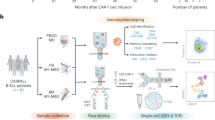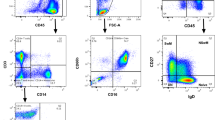Summary:
After allogeneic stem cell transplantation (SCT), we evaluated the use of the Wilms’ tumor gene (WT1) as a minimal residual disease (MRD) marker in 32 patients (28 chronic myeloid leukemia, three acute lymphoblastic leukemia and one acute myeloid leukemia). All patients expressed BCR-ABL and the kinetics of WT1 were compared with those of BCR-ABL using real-time quantitative PCR. WT1 expression was seen in the peripheral blood (PB) of healthy controls with a median expression level of 7 × 10−5 (WT1/ABL ratio). The corresponding values for BCR-ABL-negative and BCR-ABL-positive patient samples were 1 × 10−4 and 1.6 × 10−4, respectively. Kinetic studies in individual patients showed that WT1 and BCR-ABL levels usually did not copy each other. In four out of six patients who relapsed, an increase in WT1 from the background level (10−4) was observed only at the time of or after relapse, and in two patients increasing WT1 levels were observed before the relapse. In addition, the WT1 values found at the time of relapse were only two logs higher than the background level, indicating a sensitivity of 10−2. In conclusion, there is a constitutive low expression of WT1 in normal hematopoietic cells. The sensitivity and ability of WT1 to predict a relapse were poor in this study.
This is a preview of subscription content, access via your institution
Access options
Subscribe to this journal
Receive 12 print issues and online access
$259.00 per year
only $21.58 per issue
Buy this article
- Purchase on Springer Link
- Instant access to full article PDF
Prices may be subject to local taxes which are calculated during checkout




Similar content being viewed by others
References
Maurer J, Janssen JW, Thiel E et al. Detection of chimeric BCR-ABL genes in acute lymphoblastic leukaemia by the polymerase chain reaction. Lancet 1991; 337: 1055–1058.
Paietta E, Racevskis J, Bennett JM et al. Biologic heterogeneity in Philadelphia chromosome-positive acute leukemia with myeloid morphology: the Eastern Cooperative Oncology Group experience. Leukemia 1998; 12: 1881–1885.
Cross NC, Feng L, Chase A et al. Competitive polymerase chain reaction to estimate the number of BCR-ABL transcripts in chronic myeloid leukemia patients after bone marrow transplantation. Blood 1993; 82: 1929–1936.
Olavarria E, Kanfer E, Szydlo R et al. Early detection of BCR-ABL transcripts by quantitative reverse transcriptase-polymerase chain reaction predicts outcome after allogeneic stem cell transplantation for chronic myeloid leukemia. Blood 2001; 97: 1560–1565.
Radich JP, Gehly G, Gooley T et al. Polymerase chain reaction detection of the BCR-ABL fusion transcript after allogeneic marrow transplantation for chronic myeloid leukemia: results and implications in 346 patients. Blood 1995; 85: 2632–2638.
Radich J, Gehly G, Lee A et al. Detection of bcr-abl transcripts in Philadelphia chromosome-positive acute lymphoblastic leukemia after marrow transplantation. Blood 1997; 89: 2602–2609.
Inoue K, Sugiyama H, Ogawa H et al. WT1 as a new prognostic factor and a new marker for the detection of minimal residual disease in acute leukemia. Blood 1994; 84: 3071–3079.
Bergmann L, Miething C, Maurer U et al. High levels of Wilms’ tumor gene (wt1) mRNA in acute myeloid leukemias are associated with a worse long-term outcome. Blood 1997; 90: 1217–1225.
Kreuzer KA, Saborowski A, Lupberger J et al. Fluorescent 5′-exonuclease assay for the absolute quantification of Wilms’ tumour gene (WT1) mRNA: implications for monitoring human leukaemias. Br J Haematol 2001; 114: 313–318.
Miwa H, Beran M, Saunders GF . Expression of the Wilms’ tumor gene (WT1) in human leukemias. Leukemia 1992; 6: 405–409.
Miyagi T, Ahuja H, Kubota T et al. Expression of the candidate Wilm's tumor gene, WT1, in human leukemia cells. Leukemia 1993; 7: 970–977.
Inoue K, Ogawa H, Yamagami T et al. Long-term follow-up of minimal residual disease in leukemia patients by monitoring WT1 (Wilms tumor gene) expression levels. Blood 1996; 88: 2267–2278.
Kletzel M, Olzewski M, Huang W, Chou PM . Utility of WT1 as a reliable tool for the detection of minimal residual disease in children with leukemia. Pediatr Dev Pathol 2002; 5: 269–275.
Ogawa H, Tamaki H, Ikegame K et al. The usefulness of monitoring WT1 gene transcripts for the prediction and management of relapse following allogeneic stem cell transplantation in acute type leukemia. Blood 2003; 101: 1698–1704.
Gaiger A, Schmid D, Heinze G et al. Detection of the WT1 transcript by RT-PCR in complete remission has no prognostic relevance in de novo acute myeloid leukemia. Leukemia 1998; 12: 1886–1894.
Elmaagacli AH, Beelen DW, Trenschel R, Schaefer UW . The detection of wt-1 transcripts is not associated with an increased leukemic relapse rate in patients with acute leukemia after allogeneic bone marrow or peripheral blood stem cell transplantation. Bone Marrow Transplant 2000; 25: 91–96.
Schmid D, Heinze G, Linnerth B et al. Prognostic significance of WT1 gene expression at diagnosis in adult de novo acute myeloid leukemia. Leukemia 1997; 11: 639–643.
Mattsson J, Uzunel M, Brune M et al. Mixed chimaerism is common at the time of acute graft-versus-host disease and disease response in patients receiving non-myeloablative conditioning and allogeneic stem cell transplantation. Br J Haematol 2001; 115: 935–944.
Ringden O, Remberger M, Persson U et al. Similar incidence of graft-versus-host disease using HLA-A, -B and -DR identical unrelated bone marrow donors as with HLA-identical siblings. Bone Marrow Transplant 1995; 15: 619–625.
Carlens S, Ringden O, Aschan J et al. Risk factors in bone marrow transplant recipients with leukaemia. Increased relapse risk in patients treated with ciprofloxacin for gut decontamination. Clin Transplant 1998; 12: 84–92.
Giralt SA, Champlin RE . Leukemia relapse after allogeneic bone marrow transplantation: a review. Blood 1994; 84: 3603–3612.
Thomas ED, Buckner CD, Banaji M et al. One hundred patients with acute leukemia treated by chemotherapy, total body irradiation, and allogeneic marrow transplantation. Blood 1977; 49: 511–533.
Kolb HJ, Schattenberg A, Goldman JM et al. Graft-versus-leukemia effect of donor lymphocyte transfusions in marrow grafted patients. European Group for Blood and Marrow Transplantation Working Party Chronic Leukemia. Blood 1995; 86: 2041–2050.
Bader P, Klingebiel T, Schaudt A et al. Prevention of relapse in pediatric patients with acute leukemias and MDS after allogeneic SCT by early immunotherapy initiated on the basis of increasing mixed chimerism: a single center experience of 12 children. Leukemia 1999; 13: 2079–2086.
Dazzi F, Szydlo RM, Cross NC et al. Durability of responses following donor lymphocyte infusions for patients who relapse after allogeneic stem cell transplantation for chronic myeloid leukemia. Blood 2000; 96: 2712–2716.
Cilloni D, Gottardi E, De Micheli D et al. Quantitative assessment of WT1 expression by real time quantitative PCR may be a useful tool for monitoring minimal residual disease in acute leukemia patients. Leukemia 2002; 16: 2115–2121.
Cross NC . Minimal residual disease in chronic myeloid leukaemia. Hematol Cell Ther 1998; 40: 224–228.
Emig M, Saussele S, Wittor H et al. Accurate and rapid analysis of residual disease in patients with CML using specific fluorescent hybridization probes for real time quantitative RT-PCR. Leukemia 1999; 13: 1825–1832.
Lin F, Goldman JM, Cross NC . A comparison of the sensitivity of blood and bone marrow for the detection of minimal residual disease in chronic myeloid leukaemia. Br J Haematol 1994; 86: 683–685.
Coustan-Smith E, Sancho J, Hancock ML et al. Use of peripheral blood instead of bone marrow to monitor residual disease in children with acute lymphoblastic leukemia. Blood 2002; 100: 2399–2402.
van der Velden VH, Jacobs DC, Wijkhuijs AJ et al. Minimal residual disease levels in bone marrow and peripheral blood are comparable in children with T cell acute lymphoblastic leukemia (ALL), but not in precursor-B-ALL. Leukemia 2002; 16: 1432–1436.
Acknowledgements
We thank the staff at the Center for Allogeneic Stem Cell Transplantation and the Departments of Pediatrics and Hematology for excellent and skilful patient care. We also thank Dr Albert Bekassy for the help with some of the patient data. This study was supported by grants from the Swedish Cancer Society (0070-B99-13XAC), the Children's Cancer Foundation (2000/067), the Swedish Medical Research Council (K2000-06X-05971-20A), the Cancer Society in Stockholm and the Tobias Foundation.
Author information
Authors and Affiliations
Corresponding author
Rights and permissions
About this article
Cite this article
Uzunel, M., Ringdén, O. Poor correlation of kinetics between BCR-ABL and WT1 transcript levels after allogeneic stem cell transplantation. Bone Marrow Transplant 33, 47–52 (2004). https://doi.org/10.1038/sj.bmt.1704296
Received:
Accepted:
Published:
Issue Date:
DOI: https://doi.org/10.1038/sj.bmt.1704296
Keywords
This article is cited by
-
Wilms’ tumor gene 1 expression: an independent acute leukemia prognostic indicator following allogeneic hematopoietic SCT
Bone Marrow Transplantation (2012)
-
Monitoring of minimal residual disease using WT1 assay for patients with chronic myeloid leukemia who undergo allogeneic stem cell transplantation
Bone Marrow Transplantation (2004)



